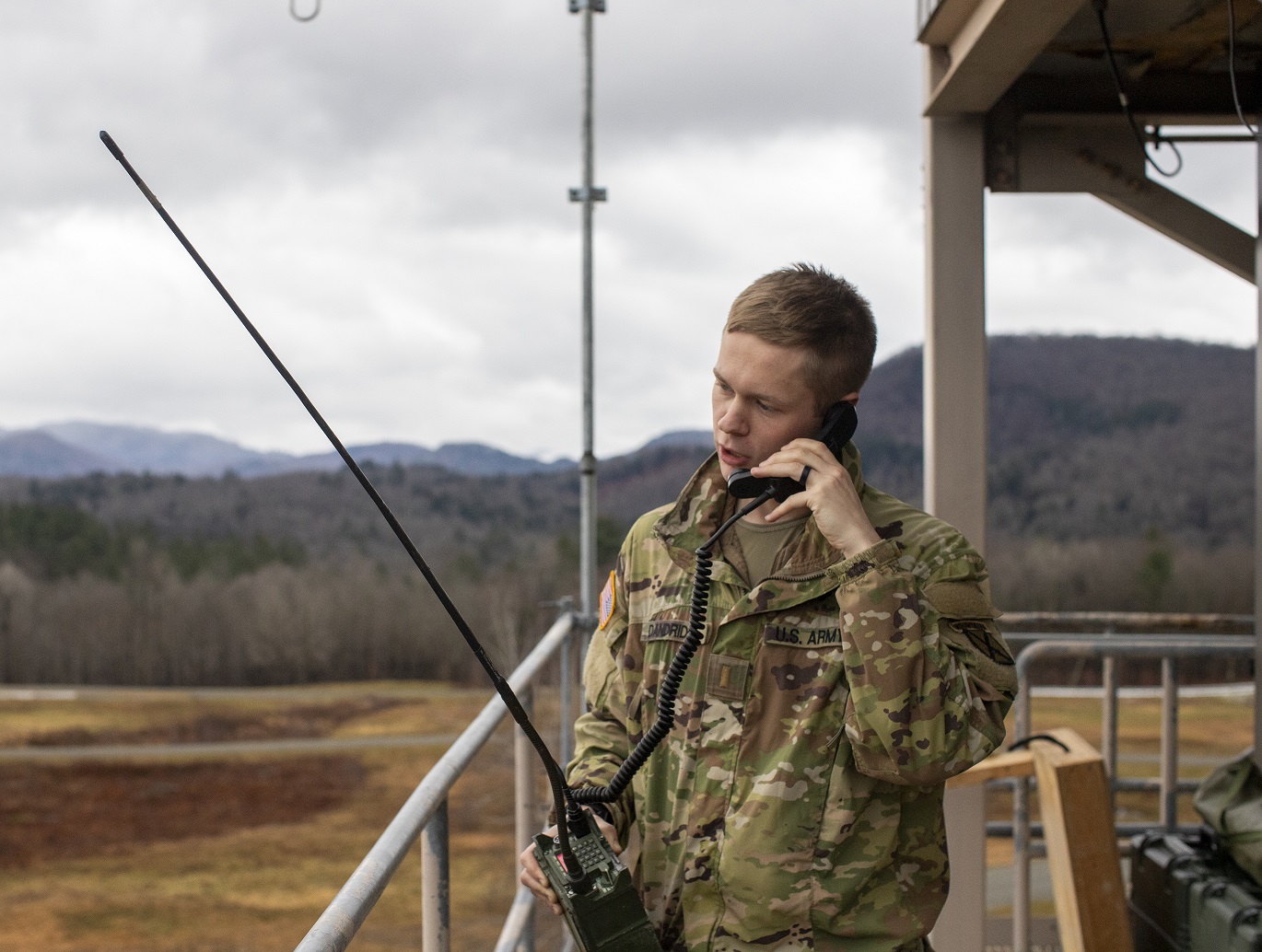

Above left: Cpl. Noah Weston, a signal operations support specialist with 10th Mountain Division Artillery, helps his squad set up a quick erecting antenna mast to achieve line-of-sight communication at Ethan Allen, Vermont, on Dec. 2. Above right: Second Lt. Joseph Dandridge, a signal officer with 10th Mountain Division Artillery, establishes communications Dec. 3 using a single channel ground and airborne radio system with DIVARTY, at Fort Drum, New York, from Ethan Allen, Vermont. The Hunter EMS VII exercise aimed to validate and improve the division's operational capacity in an ever-evolving battlefield by combining kinetic and non-kinetic effects. (U.S. Army Photos by Spc. Kaylan Joseph, 27th Public Affairs Detachment)
10th Mountain Division Soldiers conduct Hunter EMS VIIb exercise in N.Y., Vermont
Spc. Kasimir Jackson
27th Public Affairs Detachment
FORT DRUM, N.Y. (Dec. 8, 2023) — Soldiers of the 10th Mountain Division (LI) conducted the Hunter-Electromagnetic Spectrum VIIb exercise, Nov. 30 to Dec. 5, spanning Fort Drum and Camp Ethan Allen in Vermont.
This beyond line-of-sight exercise covered approximately 150 miles, aiming to enhance communications and safeguard Soldiers operating within the electromagnetic spectrum using new technologies and techniques.
The Hunter-EMS series revolves around experimentation and innovation. In contrast to Hunter-EMS VI, VIIb focused more heavily on creating and blocking lines of communication during potential multi-domain operations.
“Bringing all these pieces together, we are examining how different echelons can support top-down guidance with bottom-up refinement,” said Chief Warrant Officer 3 Matthew D. Lott, electronic warfare technician for the 10th Mountain Division Artillery (DIVARTY).
According to Lott, as an alpine light infantry division, it is crucial to control the modern battlefield facing the growing prevalence of air missile defense and electronic warfare threats. Soldiers are tasked to isolate, locate simulated threats, and coordinate the appropriate response.
“To win in the next fight, we have to deny the enemy maneuverability on the electromagnetic spectrum and allow freedom for friendly units to move about,” Lott said. “We need unimpeded access. If we can’t achieve that, winning the next fight will be even more difficult!”
Staff Sgt. Caleb Anthes, AMD-EW spectrum manager in DIVARTY, said this equipment and training allow commanders to see a visual representation of their Soldiers' electromagnetic footprint while maneuvering under the spectrum.
“Electronic warfare Soldiers and spectrum managers are the future of the military,” Anthes said. “We need to continue controlling the electronic spectrum by broadening Soldiers' skills and providing them with the best equipment to prevent any unwanted scenarios.”
On Dec. 5, Lt. Col. Gregory Eldridge, 10th Mountain Division deputy fires support coordinator, and Staff Sgt. Alex Miner, a fires direction noncommissioned officer with DIVARTY Fire Control, conducted a movement up Whiteface Mountain to deploy new communication equipment.
Whiteface Mountain is home to the largest vertical drop east of the Rockies, and these Soldiers used their alpine skills, harkening back to the roots of the 10th Mountain Division, to scale nearly 5,000 feet above sea level to establish a connection between Camp Ethan Allen and Fort Drum.
“It’s the tenacity of these Soldiers not just to operate but thrive in a multi-domain operational environment that enables us to create tactics, techniques, and procedures for survivability,” said Maj. Mark Smerka, DIVARTY fire support officer in charge.
Smerka said he believes it's the ease of available commercial technologies like Group 1 unmanned aerial systems that poses a threat to us and friendly forces.
“We need to master utilizing technology to control the electromagnetic spectrum because our adversaries are looking for any sort of advantage to impose their will,” Smerka said. “And if we don’t advance alongside technology, we will be left behind.”
Moving into the modern battlefield, Soldiers will need to develop new skills to remain efficient.
“No matter what echelon you're operating in, you still need the individual at the lowest level to execute because it’s still the individual Soldier setting up the communications tower, command node, and even the tents we are operating in,” Smerka said. “You still need teams to coordinate and come together at the right place and time.”





